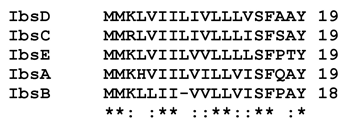You are here: Home > Section on Environmental Gene Regulation
Small Regulatory RNAs and Small Proteins

- Gisela Storz, PhD, Head, Section on Environmental Gene Regulation
- Jillian L. Astarita, BA, Predoctoral Fellow
- Chase L. Beisel, PhD, Postdoctoral Fellow
- Sylvain Durand, PhD, Visiting Fellow
- Fanette Fontaine, PhD, Visiting Fellow
- Elizabeth M. Fozo, PhD, Postdoctoral Fellow
- Matthew R. Hemm, PhD, Postdoctoral Fellow
- Errett C. Hobbs, PhD, Postdoctoral Fellow
- Kathy S. Mendieta, BA, Predoctoral Fellow
- Lauren Waters, PhD, Postdoctoral Fellow
- Aixia Zhang, PhD, Staff Scientist
Currently, we have two main interests: (1) identification and characterization of small regulatory RNAs and (2) identification and characterization of small proteins of less than 50 amino acids. Both small RNAs and small proteins have been overlooked because they are not detected in biochemical assays. In addition, most genome annotation misses the corresponding genes, which are poor targets for genetic approaches.
Identification and characterization of small regulatory RNAs
We have carried out several systematic screens for small, noncoding RNA genes in Escherichia coli. The screens are all applicable to other organisms. One approach—based on computer searches of intergenic regions for extended regions of conservation among closely related species—led to the identification of 17 conserved small RNAs. Another screen for small RNAs that coimmunoprecipitate with the RNA-binding protein Hfq allowed us to detect six less well-conserved RNAs. A third approach—size fractionation of total RNA followed by linker ligation and cDNA synthesis—resulted in the identification of yet other small RNAs. We recently obtained tiled microarrays that provide coverage of the entire E. coli genome and are now using the arrays to extend our identification of small RNAs.
Increasingly, we have been focusing on elucidating the functions of the small RNAs in E. coli. We previously showed that the OxyS RNA, whose expression is induced in response to oxidative stress, represses translation by basepairing with target mRNAs. OxyS RNA action is dependent on the Sm-like Hfq protein, which functions as a chaperone to facilitate OxyS RNA basepairing with its target mRNAs. We also discovered that the abundant 6S RNA binds to and modifies RNA polymerase. In addition, we elucidated the functions of the MicC RNA and GadY RNA, which also bind to Hfq and act by basepairing. We found that the MicC RNA represses translation of the OmpC outer membrane porin. Interestingly, under most conditions, the MicC RNA shows expression opposite that of the MicF RNA, which represses expression of the OmpF porin. Basepairing between the GadY RNA and the 3′-untranslated region (3′-UTR) of the gadX mRNA encoded opposite gadY leads to an increase in levels of the gadX mRNA and GadX protein. Increased GadX levels in turn result in increased expression of the acid-response genes controlled by the GadX transcription factor.
In one recent study, we characterized the small RNA SymR. It is encoded in cis to an SOS-induced gene whose product shows homology to the antitoxin MazE (SymE). We demonstrated that synthesis of the SymE protein is tightly repressed at several levels by the LexA repressor, the SymR RNA, and the Lon protease. SymE co-purifies with ribosomes, and overproduction of the protein leads to cell growth inhibition, decreased protein synthesis, and increased RNA degradation. These properties are shared with several RNA endonuclease toxins of the toxin-antitoxin modules, and we reported that the SymE protein represents evolution of a toxin from AbrB fold proteins, which are typically antitoxins. We suggest that SymE promotion of RNA cleavage may be important for the recycling of RNAs damaged under SOS-inducing conditions.

Figure 1. Alignment of the Ibs proteins from E. coli
In another recent study, we characterized the Sib RNAs, which are encoded by five repeats in E. coli K-12, though the number of repeats varies among E. coli strains. All five Sib RNAs in E. coli K-12 are expressed, and we observed no phenotype for a five-sib deletion strain. However, we observed a phenotype reminiscent of plasmid addiction for overexpression of the Sib RNAs. Further examination of the SIB repeat sequences revealed conserved open reading frames encoding highly hydrophobic 18–19 amino acid proteins (Ibs) opposite each sib gene (Figure 1). The Ibs proteins were toxic when overexpressed, although the toxicity could be prevented by co-expression of the corresponding Sib RNA. Two other RNAs encoded divergently in the yfhL-acpS intergenic region were similarly found to encode a small hydrophobic protein (ShoB) and an antisense RNA regulator (OhsC). Overexpression of both IbsC and ShoB led to immediate changes in membrane potential, suggesting that both proteins affect the cell envelope. Whole-genome expression analysis showed that overexpression of IbsC and ShoB, as well as of the small hydrophobic LdrD and TisB proteins, has both overlapping and unique consequences for the cell.
We are currently engaged in studies characterizing the OxyS, GadY, and Sib RNAs and elucidating the roles of other newly discovered small RNAs.
Identification and characterization of small proteins
In our genome-wide screens for small RNAs, we found that a number of short RNAs actually encode small proteins. The correct annotation of the smallest proteins is one of the biggest challenges of genome annotation, and perhaps more importantly, few annotated short ORFs have been confirmed to correspond to synthesized proteins. Although these proteins have largely been missed, the few small proteins that have been studied in detail in bacterial and mammalian cells have been shown to have important functions in signaling and in cellular defenses. Thus we established a project to identify and characterize E. coli proteins of less than 50 amino acids.
We used sequence conservation and ribosome binding site models to predict genes encoding small proteins, defined as having 16-50 amino acids, in the intergenic regions of the Escherichia coli genome. We tested expression of these predicted as well as previously annotated small proteins by integrating the sequential peptide affinity tag directly upstream of the stop codon on the chromosome and assaying for synthesis using immunoblot assays. This approach confirmed that 20 previously annotated and 18 newly discovered proteins of 16-50 amino acids are synthesized. Remarkably more than half of the newly discovered proteins are predicted to be single transmembrane proteins, nine of which we show co-fractionate with cell membranes.
We are employing many of the approaches the group has used in characterizing the functions of small regulatory RNAs to elucidate the functions of the small proteins. Systematic assays for the accumulation of tagged versions of the proteins have shown that many small proteins accumulate under specific growth conditions or after exposure to stress. We also generated and screened bar-coded null mutants and identified small proteins required for resistance to cell envelope stress and acid shock. The attached sequential peptide affinity tag is now being exploited to purify the small protein and identify co-purifying complexes. The combination of these approaches will give insights into when, where, and how the small proteins are acting.
Additional Funding
- NRC Fellowship Award to Elizabeth Fozo (2009, concluded)
- PRAT Fellowships Award to Dr. Errett Hobbs (2009, ongoing)
- PRAT Fellowship Award to Dr. Lauren Waters (2009, ongoing)
Publications
- Fozo EM, Kawano M, Fontaine F, Kaya Y, Mendieta KS, Jones KL, Ocampo A, Rudd KE, Storz G. Repression of small toxic protein synthesis by the Sib and OhsC small RNA. Mol Microbiol 2008 70:1076-1093.
- Waters LS, Storz G. Regulatory RNAs in bacteria. Cell 2009 136:615-628.
- Hemm MR, Paul BJ, Schneider TD, Storz G, Rudd KE. Small membrane proteins found by comparative genomics and ribosome binding site models. Mol Microbiol 2008 70:1487-1501.
- Fozo EM, Hemm MR, Storz G. Small antisense RNAs that regulate the expression of small toxic proteins. Microbiol Mol Biol Rev 2008 72:579-589.
Collaborators
- Susan Gottesman, PhD, Laboratory of Molecular Biology, NCI, Bethesda, MD
- Mitsuoki Kawano, PhD, RIKEN Yokohama Institute, Kanagawa, Japan
- Brian J. Paul, PhD, DuPont Central Research and Development, Wilmington, DE
- Kenneth E. Rudd, PhD, University of Miami School of Medicine, Miami, FL
- Thomas D. Schneider, PhD, Center for Cancer Research Nanobiology Program, NCI, Frederick, MD
Contact
For more information, email storz@helix.nih.gov or visit cbmp.nichd.nih.gov/segr.



